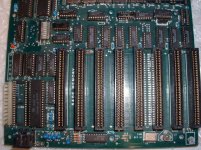As an interesting unrelated tidbit, I run a 5MHz V20 at 8MHz with no problem (i.e. it doesn't fail and there's no overheating).
Another interesting tidbit, I run an 8MHz V20 at 5MHz!
Regarding the real problem, I don't think it could beep the speaker or make the kb flash if it had a dead CPU.


